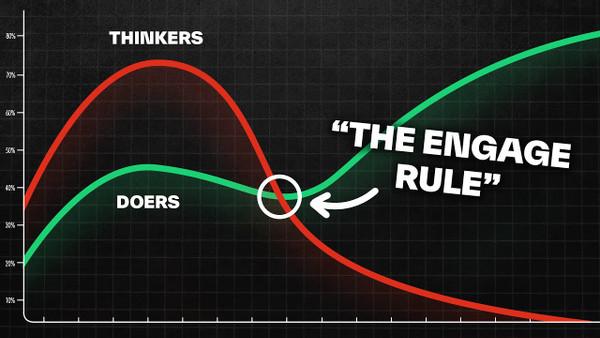Explore the World's Best Ideas
Join today and uncover 100+ curated journeys from 50+ topics. Unlock access to our mobile app with extensive features.
1. Understanding Procrastination as Approach-Avoidance Conflict
Procrastination is not simply a lack of motivation but rather a conflict between the brain's approach system and avoidance system.
This conflict causes us to experience both positive and negative aspects of a task, leading to a struggle in starting and completing it.
46
616 reads
2. The Flow Cycle for Overcoming Procrastination
The flow cycle consists of four phases: struggle, release, flow, and recovery.
Engaging in the struggle phase is key to entering the flow state where effortless attention and peak performance occur.
Understanding and mastering the flow cycle can help overcome procrastination.
48
500 reads
3. Clear Goals as a Flow Trigger
Having clear goals activates the brain's executive network and motivates us through dopamine surges.
By breaking down tasks into specific, manageable goals, we can reduce the brain's resistance to starting and engage in the flow cycle more easily.
47
437 reads
4. Tuning the Challenge-Skills Balance
Finding the right balance between the perceived challenge of a task and our perceived skill level is crucial.
If the challenge is too high, it leads to anxiety and overwhelm, while if it's too low, we become bored and apathetic.
Adjusting the challenge or the time allocated for a task can help regulate the balance and overcome procrastination.
43
352 reads
5. Response Inhibition for Procrastination
Response inhibition is the ability to override automatic reactions and choose a go-driven behaviour.
By training response inhibition, we can override the temptation to procrastinate and engage in tasks immediately, leveraging our prefrontal cortex and avoiding the approach-avoidance conflict.
46
341 reads
6. Harnessing Brain Waves for Productivity
The brain waves present during sleep, such as delta and theta waves, are similar to alpha and theta waves found in flow state.
By immediately starting focused work upon waking, we can tap into these brain waves, enhance response inhibition, increase flow likelihood, and reduce procrastination.
48
304 reads
7. Fixing the Schedule for Flow
A well-structured schedule that minimizes interruptions and enables uninterrupted flow sessions is key to reducing procrastination.
By batching meetings, booking flow blocks, and prioritizing focused work, we create an environment conducive to deep engagement and increased flow payoff.
44
277 reads
8. Differentiating between Procrastination and Ambivalence
It's important to distinguish between true procrastination and ambivalence.
Procrastination stems from the desire to avoid a task, while ambivalence signals a sense of unease or intuitive knowledge that a particular action or decision might not be beneficial.
Recognizing ambivalence in real-time can help avoid unnecessary actions and make more informed choices.
45
267 reads
9. Building Skills to Overcome Procrastination
Eliminating procrastination involves building skills such as setting clear goals, regulating the challenge-skills balance, enhancing response inhibition, and interpreting signals of ambivalence.
By consistently practicing these techniques, we can develop the ability to engage in the flow cycle and effectively manage procrastination.
46
257 reads
10. Reinforcing the Flow Payoff
The flow state offers incredible rewards, both in terms of pleasure and performance.
Ensuring a high likelihood of entering and sustaining flow by addressing the approach-avoidance conflict and designing tasks with a substantial flow payoff can motivate us to overcome procrastination and achieve extreme progression and accomplishment.
43
229 reads
Engaging in the Struggle Phase within 15 seconds
Set a clear goal, lower the hurdle on the task, then push yourself through the engage phase within those 15 seconds where people mostly start to procrastinate.
If you take too long to start, you'll overthink and stay stuck. Reduce the time between your thought and your action.
Engage with the task in 15 seconds. That is when you slide into buttery execution much easier.
52
257 reads
IDEAS CURATED BY
CURATOR'S NOTE
Approach-avoidance conflict in the brain causes procrastination, where the desire to do a task conflicts with the fear or anxiety associated with it. Clear and specific goals can help overcome procrastination by activating the motivation and planning centres in the brain. Tweaking the challenge-skill balance, regulating time, and defining the scope of a task can also help overcome procrastination.
“
Similar ideas
6 ideas
Set SIX Alarms. It’ll Change Your Life.
Rian Doris
33 ideas
Flow
Mihaly Csikszentmihalyi
6 ideas
Flow
Mihaly Csikszentmihalyi
Read & Learn
20x Faster
without
deepstash
with
deepstash
with
deepstash
Personalized microlearning
—
100+ Learning Journeys
—
Access to 200,000+ ideas
—
Access to the mobile app
—
Unlimited idea saving
—
—
Unlimited history
—
—
Unlimited listening to ideas
—
—
Downloading & offline access
—
—
Supercharge your mind with one idea per day
Enter your email and spend 1 minute every day to learn something new.
I agree to receive email updates
